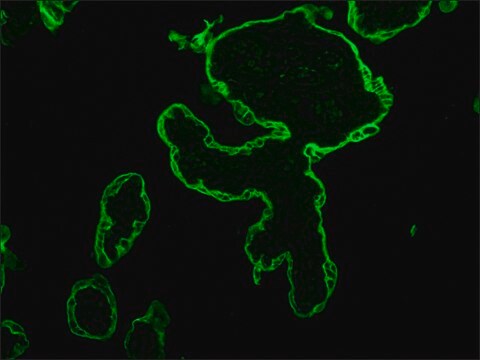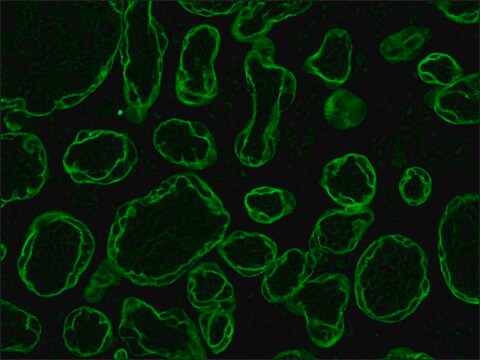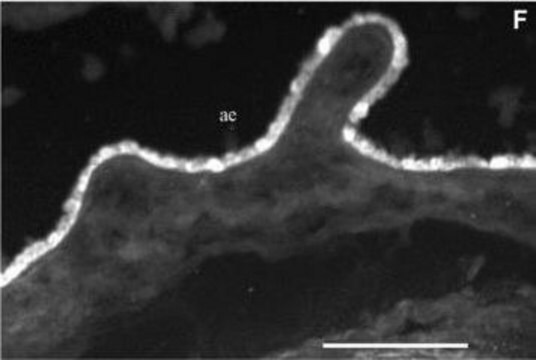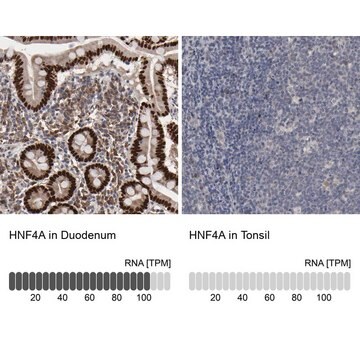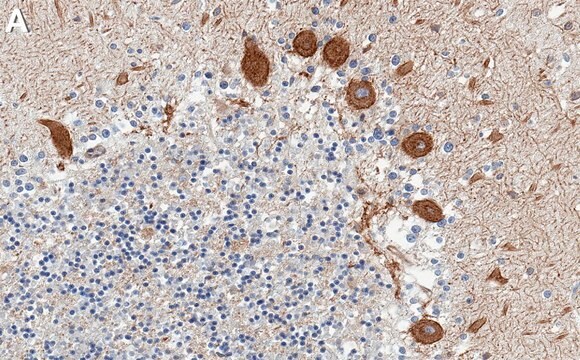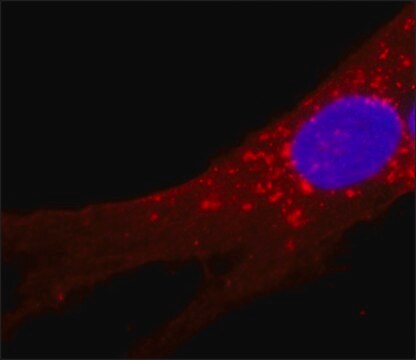推薦產品
生物源
mouse
共軛
unconjugated
抗體表格
tissue culture supernatant
抗體產品種類
primary antibodies
無性繁殖
A53-B/A2, monoclonal
分子量
antigen 40 kDa
包含
15 mM sodium azide
物種活性
human
技術
indirect immunofluorescence: 1:50 using formalin-fixed, paraffin-embedded, human tissue sections
microarray: suitable
同型
IgG2a
UniProt登錄號
運輸包裝
dry ice
儲存溫度
−20°C
目標翻譯後修改
unmodified
基因資訊
human ... KRT19(3880)
一般說明
Monoclonal Anti-Cytokeratin Peptide 19 (mouse IgG2a isotype) is derived from the A53-B/A2 hybridoma produced by the fusion of mouse myeloma cells and splenocytes from BALB/c mice immunized with mammary human carcinoma cell line MCF-7. Monoclonal Anti-Cytokeratin Peptide 19, known as clone A53-B/A2, or clone No. Ks 19.1, reacts with the rod domain of human cytokeratin peptide 19 (40 kDa), a cytoskeletal protein restricted to epithelial and carcinoma cells. Cytokeratin 19 is a member of the type I acidic subfamily. It is differentially expressed in various human tissues.
特異性
Also cited as clone no. KS 19.1, the antibody reacts with the rod domain of cytokeratin peptide 19, a cytoskeletal protein restricted to epithelial and carcinoma cells. Species cross-reactivity is low or absent. The antibody labels simple epithelia and basal cells of non-cornifying stratified squamous epithelia. It is a useful tool in discriminating simple carcinomas from those of different origin and for carcinoma subtyping. This antibody has also been shown to be a marker of pre-malignant lesions of the oral epithelium.
免疫原
human mammary carcinoma cell line MCF-7.
應用
Monoclonal Anti-Cytokeratin Peptide 19 antibody produced in mouse is also suitable:
- for immunoblotting, for immunocytochemistry,
- for immunofluorescence,
- as a marker of premalignant lesions of the oral epithelium, to label cytokeratin in formalin-fixed or Carnoy-fixed, paraffin embedded tissue and in frozen sections of human tissue, to label simple epithelia and basal cells of noncornifying stratified squamous epithelia.
Monoclonal Anti-Cytokeratin Peptide 19 antibody produced in mouse is suitable for microarray and indirect immunofluorescence at a dilution of 1:50 using formalin-fixed, paraffin-embedded and human tissue sections.
生化/生理作用
Keratin, type I cytoskeletal 19 (40kDa protein) is also known as cytokeratin-19 (CK-19) or keratin-19 (K19). It is encoded by the KRT19 gene in humans. Keratin 19 is a type I keratin. Keratins are intermediate filament-forming proteins that provide mechanical support and perform a variety of additional functions in epithelial cells. K19 is expressed in a subset of hepatocellular carcinomas (HCC) with poor prognosis and is considered as a biliary/hepatic progenitor cell (HPC) marker. It is also a predictor of poorer prognosis for patients with human lung squamous cell carcinoma (SCC).
Monoclonal anti-cytokeratins are specific markers of epithelial cell differentiation and have been widely used as tools in tumor identification and classification.
免責聲明
Unless otherwise stated in our catalog or other company documentation accompanying the product(s), our products are intended for research use only and are not to be used for any other purpose, which includes but is not limited to, unauthorized commercial uses, in vitro diagnostic uses, ex vivo or in vivo therapeutic uses or any type of consumption or application to humans or animals.
未找到適合的產品?
試用我們的產品選擇工具.
儲存類別代碼
10 - Combustible liquids
水污染物質分類(WGK)
nwg
閃點(°F)
Not applicable
閃點(°C)
Not applicable
分析證明 (COA)
輸入產品批次/批號來搜索 分析證明 (COA)。在產品’s標籤上找到批次和批號,寫有 ‘Lot’或‘Batch’.。
Kasper, M., et al.
European Journal of Cancer, 23, 137-137 (1987)
Izabela Podgorski et al.
The American journal of pathology, 175(3), 1255-1269 (2009-08-25)
Bone metastasis is a hallmark of advanced prostate and breast cancers, yet the critical factors behind attraction of tumors to the skeleton have not been validated. Here, we investigated the involvement of cathepsin K in the progression of prostate tumors
Minati Satpathy et al.
Theranostics, 9(3), 778-795 (2019-02-28)
Cancer heterogeneity and drug resistance limit the efficacy of cancer therapy. To address this issue, we have developed an integrated treatment protocol for effective treatment of heterogeneous ovarian cancer. Methods: An amphiphilic polymer coated magnetic iron oxide nanoparticle was conjugated
Targeted drug delivery and image-guided therapy of heterogeneous ovarian cancer using HER2-targeted theranostic nanoparticles
Satpathy M, et al.
Theranostics, 9(3), 778-778 (2019)
R Moll et al.
Laboratory investigation; a journal of technical methods and pathology, 65(1), 74-86 (1991-07-01)
The expression of intermediate filament proteins, particularly individual cytokeratins (CKs), vimentin, and glial filament protein, was immunohistochemically investigated using frozen sections and Carnoy-fixed, paraffin-embedded tissue from normal fetal and adult human kidneys as well as from pathologically altered kidneys. In
我們的科學家團隊在所有研究領域都有豐富的經驗,包括生命科學、材料科學、化學合成、色譜、分析等.
聯絡技術服務